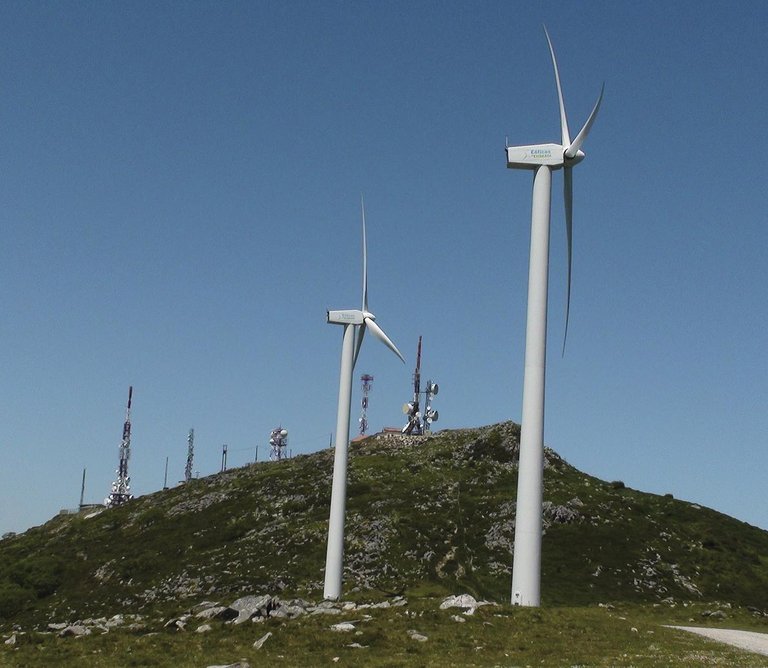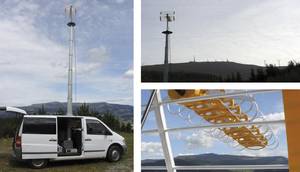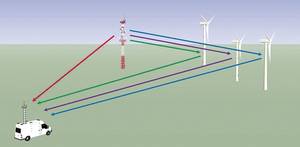Wind turbines and digital terrestrial television

Do wind farms and television have anything to do with?
Ten years ago, after the installation of thirty wind turbines on Mount Oiz, they began to have problems watching television in the Markina area. At that time, the analog signal was transmitted by two emitters located at the top. The effects on this signal were evident: the image was bent, full of interference and the brightness fluctuations were annoying for the view.
What happened then? Wind farms produce a number of effects on electromagnetic signals and, in some cases, telecommunications services offered in the environment may suffer a degradation of quality. That is, wind turbines disperse the electromagnetic signal that reaches them in all directions. In addition, when moving to generate energy, the scattering signal is variable. Therefore, the characteristics of diffuse signals depend on multiple factors, some fixed, such as the distance between the transmitter and the receiver, the size and materials of the wind turbines, and other variables in relation to time, such as the speed of rotation of the arms or the orientation of the rotor. When the main signal is combined with the scattered signal, interference can occur.
Fortunately, the Oiz problem was solved with new antennas. However, since then a long way of research has been opened. That is, on the one hand it was pending to determine the possible incidence of wind farms in digital television. On the other hand, in order to foresee possible degradations in cases similar to the current ones, a mathematical model was needed to describe the characteristics of the signal propagation.
The influence of wind farms on digital terrestrial television
Digital TV brought many benefits to analog TV: more channels, cleaner images, higher quality sound and less interference, for example. In addition, digital television needs less power than analog transmission to receive a good signal. However, it cannot bear anything. Therefore, through an empirical evaluation, we analyzed whether there was a degradation of reception caused by a wind farm in DTT and, where appropriate, its amount.
Firstly, the characteristics of the broadcast channel must be taken into account. Depending on the relative position between the transceiver turbine-receiver, two zones of influence are distinguished. In one of them, called forward scattering, the transmitter, the wind turbine and the receiver are located practically on the same line. As with light, the receiver is placed in the electromagnetic shade, in a low intensity zone. In backscattering, the deployment follows a multipath model. In other words: in addition to the main signal, a receiver receives echo signals from each wind turbine, whose behavior will be variable with respect to the time due to the rotation of the arms.
Specifically, the DVB-T system, currently used for transmission, was analyzed. To do this, we made measurements a few days in the Oiz area. Through specialized equipment and laboratory signal treatment, we measure system reception thresholds in different situations. The reception portal is the lowest relationship between the signal to be transmitted and the amplitudes of the noise signals necessary for the generation of images and sounds on television. It was concluded that, compared with the reception portals that are received in situations without wind farm, the most difficult conditions of reception occur in the backsckattering area. In addition, we had the opportunity to demonstrate that the incorporations of the reception portals that precede a wind farm depend on the intensity and temporal variability of the scattered signals. No significant effects were detected in the forward scattering zone.
These results show that a wind farm can affect the reception of the DVB-T system. However, this situation will not be the usual one and only occur under certain conditions.
Description of signal propagation
Although interference cases are rare, if problems arise, solutions are often expensive and complex. Therefore, it is preferable to foresee possible degradations in the services sent. Therefore, a new channel model has been proposed describing the usual deployment around a wind farm.
The channel model consists of four components:
- Number of signs with multiple routes, that is, number of wind turbines that make up the wind farm.
- Delay in each multichannel signal. To know the delay, the difference between the distances of the direct route (transceiver) and the indirect one (transceiver turbine-receiver) is calculated.
- Amplitude of each multipath signal, that is, the average power of the scattered signal measured in the receiver. The description of the dispersion process of the signal is done by dispersion models. These models explain the dispersion in all directions of the signal that attacks the wind turbine.
The classic dispersion models only indicate the signal dispersed by the blades, so they will not take into account the signal dispersed by the tower or the temporary variability due to the rotation movement of the arms. In addition, thanks to the measurements made in the Oiz area, we verify that these classic dispersion models do not adapt well to real signals. Therefore, a new dispersion model based on the signal dispersed by the wind turbine tower was proposed. In fact, according to simulations made through the computer, being the metal tower (unlike the arms), it is the tower itself that disperses most of the signal.
- Doppler spectrum of each multipath signal. The Doppler spectrum allows to know the nature of a variable behavior with respect to the time of the signal.
Once the measured signals are processed, we propose Doppler spectra for the channel model. Specifically, we chose three Doppler spectra, each of which represented a different situation in terms of temporal variability: high, medium and low.
In short, this channel model adapts to the specific conditions of all the cases under study, considering, among others, the relative position between transceiver turbine-receiver, the size of the wind turbine, the maximum rotation speed of the blades, the characteristics of the transmitter and the receiver antenna, as well as the frequency.
Trying to avoid problems between wind turbines and digital television
The results obtained in this work have allowed responding to the research demands raised by the International Telecommunication Union since the detection of the first cases. The International Telecommunication Union (ITU) is a specialized organization dependent on the United Nations that coordinates telecommunications networks and services. To do so, it publishes international recommendations that are not mandatory.
Prior to the start of this study, the ITU-R BT.805 recommendation on television and wind turbines was in force. This recommendation only analyzes analog television and to predict the possible impact only a turbine is taken into account, that is, the combined effect of a park composed of several wind turbines cannot be calculated.
A new recommendation called ITU-R BT.1893 was opened in 2011. This new recommendation focuses on digital television. The recommendation refers to the conclusions of this study on the quality of digital television.
However, the new recommendation also has certain limitations. For example, the dispersion model described does not correspond to the measured signals and, as with the ITU-R bt.805, represents the signal dispersed by a single wind turbine. Therefore, considering that the proposed channel model corrects these shortcomings, we will continue to strive to improve international regulation and thus avoid problems that may arise between wind turbines and telecommunications.
Bibliography
Thank you
This research work has been partially funded by the Ministry of Economy and Competitiveness (TEC2012-32370), the Basque Government (Saiotek grant program) and the University of the Basque Country (call for the hiring of specialization of doctoral researchers).
Buletina
Bidali zure helbide elektronikoa eta jaso asteroko buletina zure sarrera-ontzian













